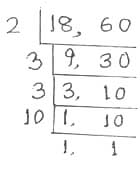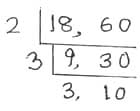Answer: Option [D]

The LCM of 18 and 60 is (2*3*3*10) = 180
Answer: Option [D]

The LCM of 18 and 60 is (2*3*3*10) = 180
Answer: Option [A]

The HCF of 18 and 60 is (3*3) = 9
Answer: Option [C]
Let the two numbers be x and (x+1) respectively
So, x(x+1) = 8372
x2 + x - 8372 = 0
x2 + 92x - 91x -8372 = 0
(x + 92)(x - 91) = 0
x = 91
Hence the two numbers are 92 and 91 and the smaller number is 91
Answer: Option [C]
Let the four consecutive even numbers be (x-2), x, (x+2) and (x+4) respectively.
Then, (x-2)+x+(x+2)+(x+4) = 100
4x + 4 = 100
x = 24
Hence the numbers are 22, 24, 26 and 26
The sum of their squares
= 222 + 242 + 262 + 282
= 2520
Answer: Option [D]
Let the five consecutive odd numbers be (x-4), (x-2), x, (x+2), (x+4) respectively.
Now, (x-4) + x = 30
x = 17
Therefore the value of E is (17+4) = 21